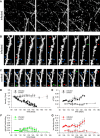Dendritic pathology in prion disease starts at the synaptic spine
- PMID: 17553995
- PMCID: PMC6672160
- DOI: 10.1523/JNEUROSCI.5062-06.2007
Dendritic pathology in prion disease starts at the synaptic spine
Abstract
Spine loss represents a common hallmark of neurodegenerative diseases. However, little is known about the underlying mechanisms, especially the relationship between spine elimination and neuritic destruction. We imaged cortical dendrites throughout a neurodegenerative disease using scrapie in mice as a model. Two-photon in vivo imaging over 2 months revealed a linear decrease of spine density. Interestingly, only persistent spines (lifetime > or = 8 d) disappeared, whereas the density of transient spines (lifetime < or = 4 d) was unaffected. Before spine loss, dendritic varicosities emerged preferentially at sites where spines protrude from the dendrite. These results implicate that the location where the spine protrudes from the dendrite may be particularly vulnerable and that dendritic varicosities may actually cause spine loss.
Figures





References
-
- Akulinin VA, Semchenko VV, Stepanov SS, Belichenko PV. Structural changes in the dendritic spines of pyramidal neurons in layer III of the sensorimotor cortex of the rat cerebral cortex in the late post-ischemic period. Neurosci Behav Physiol. 2004;34:221–227. - PubMed
-
- Belichenko PV, Dahlstrom A. Studies on the 3-dimensional architecture of dendritic spines and varicosities in human cortex by confocal laser scanning microscopy and Lucifer yellow microinjections. J Neurosci Methods. 1995;57:55–61. - PubMed
-
- Belichenko PV, Brown D, Jeffrey M, Fraser JR. Dendritic and synaptic alterations of hippocampal pyramidal neurones in scrapie-infected mice. Neuropathol Appl Neurobiol. 2000;26:143–149. - PubMed
-
- Bouzamondo-Bernstein E, Hopkins SD, Spilman P, Uyehara-Lock J, Deering C, Safar J, Prusiner SB, Ralston HJ, III, DeArmond SJ. The neurodegeneration sequence in prion diseases: evidence from functional, morphological and ultrastructural studies of the GABAergic system. J Neuropathol Exp Neurol. 2004;63:882–899. - PubMed
-
- Brown D, Belichenko P, Sales J, Jeffrey M, Fraser JR. Early loss of dendritic spines in murine scrapie revealed by confocal analysis. NeuroReport. 2001;12:179–183. - PubMed
Publication types
MeSH terms
LinkOut - more resources
Full Text Sources
Other Literature Sources
